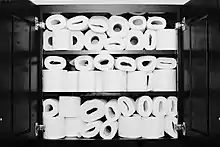Psychology of collecting
The psychology of collecting is an area of study that seeks to understand the motivating factors why people devote great amounts of time, money, and energy making and maintaining collections.

Concept of collecting
For people who collect, the value of their collections are not monetary but emotional. The collections allow people to relive their childhood, connect themselves to a period or to a time they feel strongly about. Their collections help them ease insecurity and anxiety about losing a part of themselves and to keep the past to continue to exist in the present.[1] Some collect for the thrill of the hunt. For these collectors, collecting is a quest, a lifelong pursuit which can never be completed.[2] Collecting may provide psychological security by filling a part of the self one feels is missing or is void of meaning.[3] When one collects, one experiments with arranging, organizing, and presenting a part of the world which may serve to provide a safety zone, a place of refuge where fears are calmed and insecurity is managed.[4] Motives are not mutually exclusive, rather, different motives combine for each collector for a multitude of reasons.[5]
What is collected
People can and do collect almost anything. Saint Louis collected saints’ relics and built temples for them. Collections may be antisocial, such as the collection described in Mozart’s darkest opera, Don Giovanni. Mozart’s character, Don Giovanni, scoured the town collecting sexual conquests, making his indentured servant, Leporello, follow after him, listing names in a catalog and verifying the authenticity of the account while doing so.[6] Henry Wellcome, a pharmacist, collected for society. He spent 40 years collecting over a million sharp objects that he felt represented the history of medical science. He later opened a museum, "The Museum of Medical Science", which operated during World War I.[6] The infamous are famous for their collections. Demi Moore has an entire house filled exclusively with her doll collection, Sharon Stone collects cashmere sweaters. Napoleon collected countries, a habit that led to the "Napoleon complex" cliché we use to describe a man who compensates for physical flaws through acts of aggression.
Psychologists' perspectives
.jpg.webp)
Psychologists have often taken a Freudian perspective when describing why people collect.[6] They highlight the controlling and impulsive dark side to collecting, the need for people to have "an object of desire." This desire, and hence the innate propensity to collect, begins at birth. The infant first desires the emotional and physical comfort of the nourishing breast, then the familiar baby blanket the child clings to for comfort and security. Stuffed animals, favorite toys are taken to bed and provide the emotional security needed to fall asleep. A sense of ownership and control is facilitated through possession of these items for the vulnerable child.[6] Freud himself took a more extreme position on the origins of collecting. Not surprisingly, he postulated that all collecting stems from unresolved toilet training conflict. Freud took the stance that the loss of bowel control was a traumatic experience, and the product from the bowels was disgusting and frightening to the child. Therefore, the collector is trying to gain back control of their bowels as well as their "possessions" which were long flushed down the toilet.[3] Where Freud linked object fixation to the anal-retentive stage in childhood, Muensterberger, in his perspective paper "Unruly Passion" believes collecting to be a "need-driven compensatory behavior where every new object effectively gives the notion of fantasized omnipotence." Jung had his own theories about why people become collectors. He touted the influence of archetypes on behavior. These universal symbols are embedded in what he termed our collective unconscious. Using this logic, collecting and completing sets have as their archetypal antecedents the collecting of "nuts and berries" once needed for survival by our early ancestors.[3][7]
Negative Effects
There are unemotional commerce-motivated collectors, those that hunt for collectibles only to turn them around soon after and sell them.[8] However, the current author of many autograph collecting books, Mark Baker, describes most autograph seekers as being emotionally motivated to collect. Baker (2005) estimates that over 90% of autograph collectors have no intention to sell their wares. If not for money, and assuming issues arising from childhood were long resolved, then what reasons do people give for collecting?
"For me there are three sides to it," says Petrulis, a former outfielder at St. Mary's University in Winona, Minnesota who is an avid autograph collector. "The thrill of the chase, seeing who will sign that day. Second, the collecting aspect, trying to put together one of the best autograph collections around. And, finally, feeling more connected to the game because I actually meet the guys playing it instead of just seeing them on television." Petrulis also admits there is a dark side to collecting, providing some support for views that certain passions can be bad. "It gets addictive," says Petrulis, "just like gambling, drugs or sex. It's like putting a coin in a slot machine. It might not pay off this time, so you put another quarter in and keep doing it until you are tapped out or finally hit the jackpot."
Positive Effects
Despite the interesting "dark side" of collecting, collecting is still mostly associated with positive emotions.[9] There is the happiness from adding a new find to the collection, the excitement of the hunt, the social camaraderie when sharing their collection with other collectors.[10][11] Oxlade-Vaz describes the intense emotional bond she had with her grandmother, and the rich heart-warming memories she had amassed at her grandma's house as a child and even as an adult. Her grandmother, a product of the Great Depression, "saved" everything. As a child, the author recalls the loving and gentle way her grandmother organized seemingly ordinary items: rubber bands were neatly bound together and artfully displayed on the mantle. Tops of pens of all colors and sizes were neatly arranged in drawers and bins. Artificial flowers, saved from the dumpster decorated every room in the house. At her grandmother's death, Oxlade-Vaz recalls the overwhelmingly pleasant emotions that overcame her as she sorted through her grandma's collections. Though not valuable, the author kept these collections to remember her grandma's thrifty, sensible, wisdom—reminders of the graceful way her grandmother was able to provide seemingly useless items dignity and respect.
Hoarding

There are also times when collecting is not pleasant for anyone— and much harder to describe than simply dark. There are those who have surpassed healthy collecting behavior and can be considered hoarders. Mere collecting can cross into the realm of hoarding when it also becomes pathological. Hoarding is pathological nature can be attributed to its interference with living a normal life.[12] The differences between collecting and hoarding are apparent: Items in a collection are neatly organized, maintained, and presented or manipulated with ease. If a collector of 1000+ trains wishes to find a particular specimen from their collection, they can find it easily. Collections are often catalogued, sorted, and objectively maintained like books in a library. Hoarding behavior is the opposite. Items with no value or clear utility are piled in stacks with neither order nor reason. Steven W. Anderson, a neurologist specializing in hoarding behavior, posits that the need to collect stems from the basic drive to collect basic supplies such as food. This drive originates in the subcortical and limbic portions of the brain. According to Anderson, people need their prefrontal cortex to determine what supplies are worth saving (or hoarding). Anderson has found that many compulsive hoarders with brain injuries have suffered damage to a region of their brain responsible for the regulation of cognitive behaviors such as decision making, information processing, and organizing behavior— the prefrontal cortex. Those with brain injuries who did not display hoarding behavior possessed no damage to their frontal cortex, but showed damage distributed throughout the right and left hemispheres of their brain.[13]
References
- Rykwert, J. (2001). "WHY COLLECT?". History Today. 51: 12 – via EBSCOhost.
- McKinley, 2007
- McKinley, 2005
- Schwartz, 1999
- Mueller, Shirley M. (2019). Inside the head of a collector : neuropsychological forces at play. Seattle. ISBN 978-0-9996522-7-5. OCLC 1083575943.
- Rykwert, 2001
- Phelps, Marianne (1994). Catechism of the Catholic Church. Washington, DC 20017-1194: United States Catholic Conference. pp. 436–437. ISBN 978-1-55586-511-5.CS1 maint: location (link)
- McCallum, 2005
- Swartz, 1999
- Oxlade-Vaz, 2010
- Shirley M. Mueller, “The Neuropsychology of the Collector,” in Collectible Investments for the High Net Worth Investor. Editor: Steven Satchell, Academic Press, 2009, pages 31-51
- Frost & Hristova, 2011
- Steketee, Frost, & Kyrios, 2003
- Frost, R. O., & Hristova, V. (2011). Assessment of hoarding. Journal of Clinical Psychology, 67(5), 456–466. doi:10.1002/jclp.20790.
- McCallum, J. (2005). Will You Please Sign This? Sports Illustrated, 103(19), 50. Retrieved from EBSCOhost.
- McKinley, Mark. (2007). The psychology of collecting. The Washington Post Online. Retrieved from http://nationalpsychologist.com/2007/01/the-psychology-of-collecting/10904.html.
- McKinley, Mark (2005). The psychology of collecting. Retrieved from http://www.talkingclocks.net/collecting.pdf.
- Oxlade-Vaz, G. (2010). Making money make sense. Retrieved from http://gailvazoxlade.com/blog/archives/2501.
- Rykwert, J. (2001). WHY COLLECT?. History Today, 51(12), 32. Retrieved from EBSCOhost.
- Schwartz, K. J. (1999). Remembering Grandma. Twin Brooks Antiques and Collectibles. Retrieved from http://www.msjudith.net/other/040599.htm.
- Steketee, G., Frost, R., & Kyrios, M. (2003). Cognitive aspects of compulsive hoarding. Cognitive Therapy and Research